More than a difference between Sound and Bay
Thoughts about what distinguishes Long Island Sound from
Chesapeake Bay
By Daria Blackwell
A recent turn of events that caused us to deliver our newly acquired yacht, Aleria, a vintage Bowman 57, from
Oxford
on the
Chesapeake Bay
to
Rye
on Long Island Sound made us think once again about a subject we had put aside during our years of cruising the Sound. Both the Sound and the Bay provide a rich experience for the cruiser, with plenty of charming and lovely destinations, lots of things to do shoreside, and great opportunity to hone your sailing skills. The question revolves around the vastly different culture and feeling of cruising the two bodies of water. It’s not just a matter of geography. It goes well beyond. We think we may have discovered some of the reasons for the differences. We’d like to share some of our thinking to get it off our minds and onto yours.
The screwpile (left) is as characteristic of Chesapeake Bay as the stone colonial (right) is of Long Island Sound.
Copyright (c) 2006 Daria Blackwell.
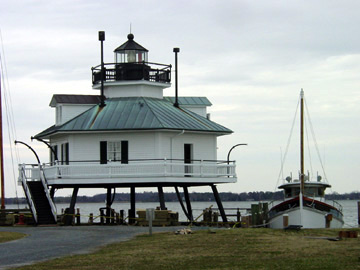 |
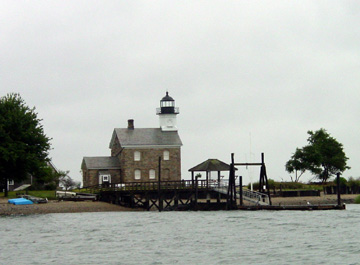 |
Gathering the information
When we first started cruising Long Island Sound, both Alex and I were new to the area. We decided to buy a boat and sail close to home; Long Island Sound seemed like the ideal place. I’d sailed there once before a generation ago and studied ecology along its shores, but Alex had always heard it was shallow and rocky and he imagined a good place for windsurfing but not for cruising. How could I convince him otherwise?
With my experience on the
Chesapeake (I had sailed out of Oxford MD for several years)
, where there’s information about every aspect of the Bay from fishing to cruising to history and natural history, I set out to thoroughly research the Sound. I went to local bookstores, checked online, and searched the maritime book specialists. I found a cruising guide or two, but no current narratives about the people, the places, and the history. I kept digging and finally found several out-of-print books that I quickly acquired, and eventually two new books were published as I continued my search.
That’s when we found out what a well kept secret Long Island Sound really is. What we didn’t understand was why. They are both estuaries although the Sound is more of a tidal river flowing from the
Atlantic
at one end to the
Atlantic
at the other end. Both have lots of protected and lovely shoreline in bays and tributaries and inlets, though the
Chesapeake
has more of everything. There was a time at the turn of the century when the Sound was known far and wide for its beaches and shore side activities. Steamships plied the waters delivering people like trains from one destination to another. Teddy Roosevelt, the Vanderbilts, the Goulds and many other prominent families built their “cottages” here. Resorts catered to the wealthy. What made the Sound subside in popularity? Where could we find the answers?
I continued collecting books about LIS and its environs. My collection has grown steadily and now includes the requisite cruising guides, guides to biking and hiking on Long Island, guides to coastal activities in Connecticut, several natural history books, and a couple of articles including one fascinating feature published in National Geographic many years ago. But the collection is still rather paltry compared with the volume of literature exalting the virtues of the
Chesapeake
I acquired in a very short time while boating there.
In fact, it hasn’t been easy to find resources about the Sound at all; even though a search of “Long Island Sound” on amazon.com yielded 58,637 listings, most of them were out of print US government archives or survey documents (as of Dec 2003). In the first 10 listings, only two were in print. That’s changed in the last year with the publication of several new books and cruising guides, but if you go past the top 10, not one of the next 10 is in print! The little useful information available about Long Island Sound is also overshadowed by the negative scientific reports that various government agencies and private foundations have published over the years.
A search for “
Chesapeake Bay
” on amazon.com yielded only 3,942 listings, yet virtually all of them were relevant, current, and interesting. The first ten covered fishing, Chesapeake Bay retrievers, cruising guides, fiction, ecopolitics, adventure, skipjacks, and of course blue crabs. If you’re about to go cruising or even bed and breakfasting there, you’ll find lots of information about how and where. The volumes of interesting books about the
Chesapeake
make you want to visit it and fall in love with it.
What’s different and what’s not?
We know now from personal experience that there is so much that’s wonderful about the Sound. Why is it so much harder to find out about it? We started to think about what’s different about the two bodies of water to try to determine the root of the issue. But first, we thought it would help to identify and rule out the similarities:
An egret and a swan. Which place is which?
Copyright (c) 2006 Daria Blackwell.
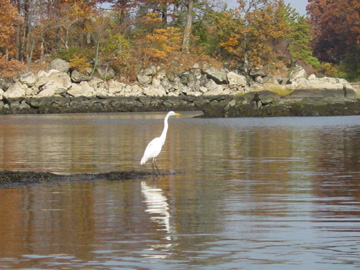 |
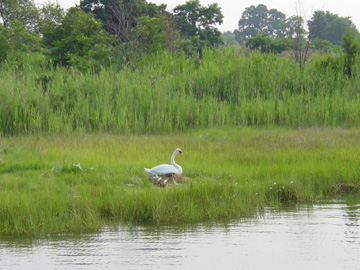 |
- Both
Chesapeake Bay
and Long Island Sound have an entrance point at one end and an exit out the other, permitting waterway transit all the way through. It happens to be wide at one end and narrow at the other end for both, so that can’t be at the bottom of the dilemma.
- Both are fed by tributaries from multiple states and are bordered by multiple states, creating political challenges in managing the watersheds and their development
- Both have wonderful cruising destinations that are within a weekend’s sail away of anywhere on their shores
- Both have active fisheries that are facing various states of crisis
- Both have similar seasons with the
Chesapeake
season slightly longer, but not dramatically different enough to account for the major differences
Whereas mooring fields are more dominant on LIS (left) to accomodate the tidal variation, marinas and anchorages are perhaps somewhat more dominant on the Chesapeake (right) because tides are less of a factor.
Copyright (c) 2006 Daria Blackwell.
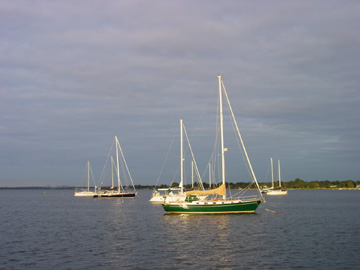 |
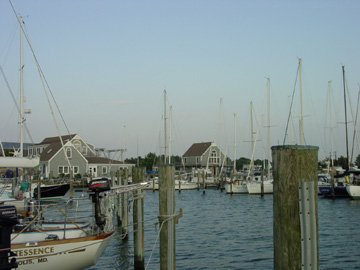 |
Next, we tried to identify and characterize the differences hoping to find some key that would help us understand and perhaps locate the resources that we were searching for:
- Long Island Sound is heavily club racing focused. We are always perplexed by racers who take down their sails and motor home on a beautiful afternoon after the races when home is some distance away and the wind is blowing.
Chesapeake Bay
, renown as a cruising destination, has a strong racing heritage but racers are just as apt to go out for a sunset cruise, which perhaps is why they also seem more supportive of long-distance racing and cruising rallys.
- Chesapeake Bay town life is focused outward toward the water with yachting and tourism as central concerns (Annapolis, St. Michael’s, Oxford, Easton, Rock Hall, Solomons, even Baltimore, etc) while Long Island Sound life seems mainly focused inward toward the land (Rye, Greenwich, Stamford, Bridgeport, New Haven, Groton, even Port Jefferson and Northport) without a strong eye toward tourism; despite the large number of yachts in the harbors, access to the towns and shoreside activities is not always easy for visitors. The closest major nautical center is
Newport
beyond the defined boundaries of Long Island Sound.
- Population density on the Sound is much higher directly on the water, characterized by industrial centers like
Bridgeport
,
New Haven
, and
Groton
. The outskirts of NYC including the
Bronx
stretch right out around the western Sound. The
Chesapeake
, on the other hand, tends to be more pastoral along the shore, with population centers up the rivers (Baltimore/Washington) and numerous remote areas of natural beauty along the Bay.
-
There are loads of publications about CB while just a limited few abouot LIS. WindCheck and SpinSheet are the LIS and CB sailing rags, respectively.
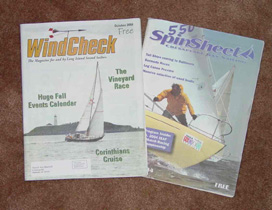 |
Chesapeake Bay
has multiple publishers focused on the region (
Chesapeake Bay
Magazine, Spinsheet, Tidewater Times, Tidewater Publishers) that contribute magazines, books, and guides to the regional publicity. Long Island Sound has two dedicated boating publications (LIS Boating and WindCheck) that are young in comparison and there are no book publishers concentrating on local works that I am aware of. Writers like John Rousmaniere, James Michener, Tom Clancy, and Nora Roberts among others have made the
Chesapeake
famous. Long Island Sound has Captain Kidd’s fortune, Nelson DeMille (The Charm School, Gold Coast,
Plum
Island
) and Billy Joel to revel in, but no major recent intrigues or claims to fame.
-
Chesapeake Bay
has a strong, well-established activist community intent on preserving the Bay (Chesapeake Bay Foundation among others) and supported by the
University
of
Maryland
research programs while the activist community on Long Island Sound (Soundkeeper and Save the Sound) seems to be just getting off the ground and perhaps a bit segmented. U Conn’s Oceanography Programs and SUNY’s
Marine
Sciences
Research
Center
should help boost the efforts.
- Tidal variation on the
Chesapeake
(generally <2 feet) is less than in most places on the Sound (often 7-9 feet). The
Chesapeake
is so shallow with a soft bottom and limited currents, while the Sound is just a bit deeper with a hard bottom and strong currents. Does that make cruising more daunting in the Sound with careful navigation to contend with, or is grounding in soft mud on the
Chesapeake
just an expectation? There's a saying, “If you haven’t gone aground on the
Chesapeake
, you’re either lying or you haven’t been anywhere worth going.”
- Long Island Sound is bordered by other great cruising destinations that are easy to get to without going far off shore (Newport/Narragansett Bay,
Peconic
Bay
, the
Islands
[
Martha’s Vineyard
,
Nantucket
,
Block Island
, and Cuttyhunk] ,
Buzzard's Bay
). As a result, the Sound seems to be more often considered an area to transit in an overnight leg to reach farther destinations while
Chesapeake Bay
is in itself the destination.
- Of course, there are also the differences in wildlife populations, with the Chesapeake state bird being the mosquito and their claim to culinary fame the blue crab, while on LIS the black fly and horse fly assaults can drive a sane man overboard and the lobster rules the seas. Of course oystering used to be a way of life in both places that no longer exists in either.
The people, the place, and the emotional connections.
Over the last five years, we’ve cruised roughly 1500 miles per season mostly around Long Island Sound. At first, it was hard to learn where to leave a dinghy shoreside, and it’s still not easy locating a dinghy dock in places we haven’t been before. The communities are not as geared toward visitors by sea, possibly because most of the people come by ferry or by land for day sailing. We’ve noticed comparatively few overnight weekend cruisers on the Sound compared with the Bay.
Whereas LIS is more racing oriented, CB is the cruising destination.
Copyright (c) 2006 Daria Blackwell.
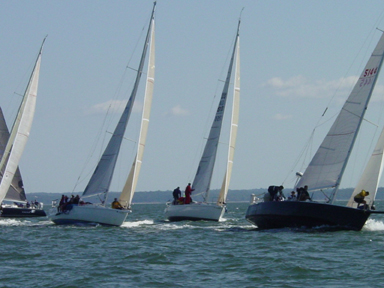 |
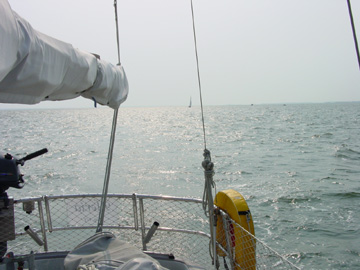 |
Is it that Long Island Sound boaters are more racing oriented whereas
Chesapeake Bay
boaters are more cruising and fishing oriented? Is it population density or inward focus that contributes to a perceived difference? Is it that there are fewer resources to publicize the virtues of Long Island Sound? We don’t know the answer. In fact, all we’ve managed to find are a lot of questions.
Three differences between LIS and CB that seem most compelling include:
- a balance between racing and cruising on The Bay while The Sound seems more weekend racing oriented
- focal points for water activities in a central location (
Annapolis
) and on two shores (St. Michaels/Oxford/Easton) compared with no true concentrated yachting center on the Sound despite many harbors (Northport and Port Jefferson seem closest but they’re not a
Newport
or
Annapolis
)
- publicity (CBF, fiction settings, magazine articles, etc) about Bay activities, heritage, and concerns but not about the Sound
We do feel less sense of contiguous community – or perhaps it’s just a greater sense of diversity – along the Sound. We’re not sure if that’s good, if it’s bad, or if it’s just different. Environmentally speaking, things don’t seem to be getting as much attention as they are on the Bay – or at least we don’t hear about it as much – but neither body of water is in great shape. The decline of lobsters and oysters on the Sound, and crabs and oysters on the Bay seem to reflect relatively equivalent pressures on the environment and commercial fishing. What’s missing from the equation?
Alex and I did not live here during the period of time when the future of the Sound seemed extremely dire as a result of extreme pollution. Perhaps that’s when communities turned their focus inland away from the water. The industrial waterfront centers of many communities had failed as well. Slowly, as the health of the water and the wildlife improves (and it is improving), perhaps the waterfront will be reclaimed and the outward focus will resume. Community involvement, pride, and publicity often help turn the tide. Maybe that’s the key factor.
We came to three interconnected conclusions about what may be at the root of the differences:
- It’s much easier to experience a place and its people when there is a lot of information available to guide us
- It’s much easier to create a library of information if there are local writers and publishers living the life and carrying the message
- It’s much easier to create a sense of community if there is a means of disseminating information to its members and creating excitement and pride in its environs
It may all come down to the tools of communication. Long Island Sound has some of the best cruising territory around. How can we create a greater sense of community and cruiser-friendly access to it? How can we refocus the interest to the waterfront and its redevelopment? It’s about more than a place. It’s about the people, the place, and the emotional connection between the two. Would sense of community and interconnectivity help build the experience for recreational boaters of NY, CT, and RI?
Promotional opportunities
 Maybe LIS needs a Sound monster. Chessie is quite the ambassador for the Bay. My vote is for LISsie, the giant oyster, who lives just inside the Race and sucks the water in and out of the Sound to feed on its nutrients. She can be the trusted water quality monitor as well as the heroic purifier, removing all traces of pollutants but feeling ill when they’re overly taxing.
Maybe LIS needs a Sound monster. Chessie is quite the ambassador for the Bay. My vote is for LISsie, the giant oyster, who lives just inside the Race and sucks the water in and out of the Sound to feed on its nutrients. She can be the trusted water quality monitor as well as the heroic purifier, removing all traces of pollutants but feeling ill when they’re overly taxing.
Maybe a historic novel like Michener’s epic
Chesapeake
would do it – “THE SOUND” has a good ring to it, doesn’t it? How about a new seafood spice called Execution Rock Salt? Maybe a series of oceanographic mysteries connecting the submarine base in Groton to the biological facilities on Plum Island, and requiring a hero from SUNY to team up with a heroine from UConn to solve the first of many mysteries. There must be a famous writer living along the shores here who can take on the task of changing the history for billions to come - above and below the waters. Perhaps Billy Joel or Jimmy Buffet, both local residents could pitch in and pen more songs about it.
Maybe Long Island Sound boaters just need to make more of what they have, because it surely is great! Or, maybe they just need to share the passion – one person at a time. Each one, teach one. That could be a good place to start. Then again, maybe keeping the secret is just fine because they love it when everyone goes home before dark and they’re left alone in an anchorage with plenty of room to swing.
Nope, that just won't do. We'll each just have to do our part in getting the word out and getting more people out there to enjoy the promises cruising holds, wherever we choose to do it!
More thoughts about CB vs LIS
Further reading:









 Maybe LIS needs a Sound monster. Chessie is quite the ambassador for the Bay. My vote is for LISsie, the giant oyster, who lives just inside the Race and sucks the water in and out of the Sound to feed on its nutrients. She can be the trusted water quality monitor as well as the heroic purifier, removing all traces of pollutants but feeling ill when they’re overly taxing.
Maybe LIS needs a Sound monster. Chessie is quite the ambassador for the Bay. My vote is for LISsie, the giant oyster, who lives just inside the Race and sucks the water in and out of the Sound to feed on its nutrients. She can be the trusted water quality monitor as well as the heroic purifier, removing all traces of pollutants but feeling ill when they’re overly taxing.